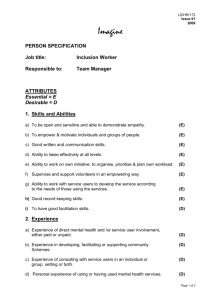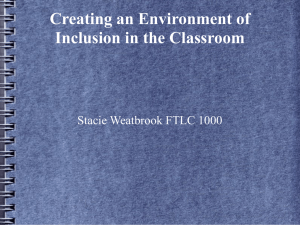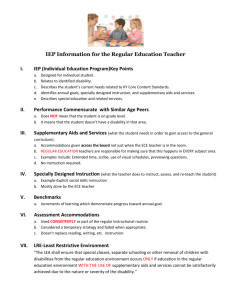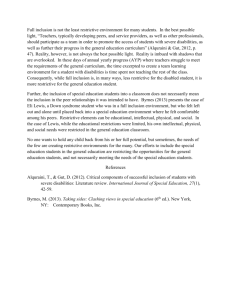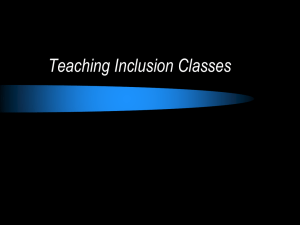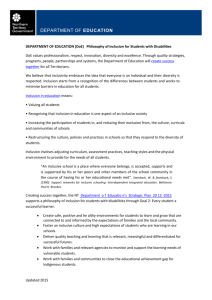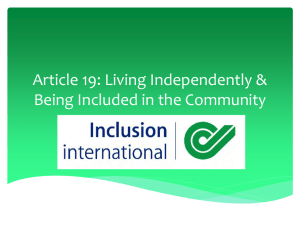Grace Russolillo
advertisement
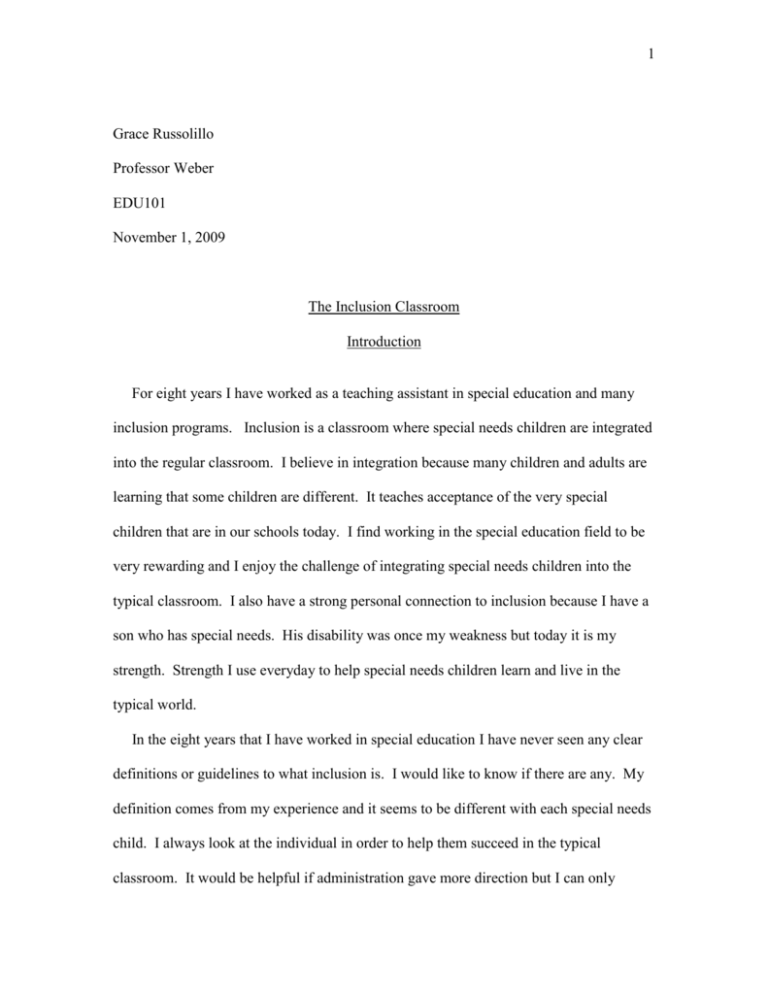
1 Grace Russolillo Professor Weber EDU101 November 1, 2009 The Inclusion Classroom Introduction For eight years I have worked as a teaching assistant in special education and many inclusion programs. Inclusion is a classroom where special needs children are integrated into the regular classroom. I believe in integration because many children and adults are learning that some children are different. It teaches acceptance of the very special children that are in our schools today. I find working in the special education field to be very rewarding and I enjoy the challenge of integrating special needs children into the typical classroom. I also have a strong personal connection to inclusion because I have a son who has special needs. His disability was once my weakness but today it is my strength. Strength I use everyday to help special needs children learn and live in the typical world. In the eight years that I have worked in special education I have never seen any clear definitions or guidelines to what inclusion is. I would like to know if there are any. My definition comes from my experience and it seems to be different with each special needs child. I always look at the individual in order to help them succeed in the typical classroom. It would be helpful if administration gave more direction but I can only 2 assume they do not have any direction to give. They seem to focus more on the budget than they do the individual child. The inclusion classroom model seems to change every year and there is no clear direction on how to make the program work. I have commitment and passion for the job that I do. I respect the children I work with and I will always work above and beyond to help them succeed. Unfortunately I haven’t seen many teachers that have that same commitment and passion. Is it due to the lack of direction, is it because of how much more difficult the cases seem to be getting or is it because of inclusion? I have many questions regarding inclusion. I would like to know how it is determined when a child is to be integrated and if there are some children being integrated when they shouldn’t be. How much should a typical classroom be able to handle? When is the disability to much that it becomes disruptive to the other children’s learning? For example, when a child screams and needs to be physically removed from the classroom many times throughout the day. When a child is so physically impaired that most of the teachers and aides time is spent dealing with the students needs to the point that the classroom is not learning and functioning like it should. There is little to no training given to aide in any of these situations. Would training teachers and aides help with the integration of these more difficult children? I would like some answers to the inclusion question and are we ever going to figure it out? I will look at the special education laws. Are there any guidelines and who is responsible for ensuring children receive the education they deserve? The laws lead us to inclusion, so why is there no clear direction? I hope to find some answers so that I can be a better Teaching Assistant with better knowledge to do my job. 3 Inclusion Classroom: The Facts The federal special education law does not require inclusion. Inclusion is not a term you will find in “The Individuals with Disabilities Act” (IDEA). IDEA provides for a free and appropriate public education to students with disabilities. IDEA states that: “Each state must establish procedures to assure that, to the maximum extent appropriate, children with disabilities…are educated with children who are not disabled, and that special education, separate schooling, or other removal of children with disabilities from the regular educational environment occurs only when the nature or severity of the disability is such that education in regular classes with the use of supplementary aids and services cannot be achieved satisfactorily.” 20 U.S.C. 1412 (5) (B). Under IDEA, school districts are required to place students in the least restrictive environment (LRE). The least restrictive environment means that, “to the maximum extent appropriate, school districts must educate students with disabilities in the regular classroom with appropriate aids and supports, referred to as “supplementary aids and services,” along with their nondisabled peers in the school they would attend if not disabled, unless a student’s individualized program requires some other arrangement.” (Wrightslaw). With the appropriate support students with disabilities are placed in the regular classroom which is the inclusion model. Some of the supports used are cooperative learning, teaching styles, physical arrangements of the classroom, curriculum modifications, peer mediated supports, computer assisted devices, and use of a resource room. The law ensures that the level of inclusion is determined by the student’s needs and not by the school district’s convenience or the parent’s wishes. School districts 4 cannot deny special education services for reasons due to lack of appropriate personnel or funds. IDEA requires that school districts develop and implement an Individual Education Plan (IEP) for each child with a disability. An IEP defines the unique needs of the disabled student and results in an individualized and appropriate education. IDEA also requires that the IEP team considers placing special needs children in the regular classroom. If that is not the determination there must be an explanation in the IEP as to why the regular classroom is not appropriate for that student. When placement is challenged in federal court, there are guidelines provided to school districts for determining appropriate placement for children with disabilities. Decisions made do not apply to all areas because each court has separate jurisdiction. Placement is made individually according to the special education child’s abilities and needs. It is the individualized program of instruction and related services in each IEP that forms the basis for placement. Factors that are relevant in determining placement according to “IDEA” are: the educational benefit to the student from regular education in comparison to the benefits of special education; the benefit to the disabled student from interacting with nondisabled students; and the degree of disruption of the education of the other students resulting in the inability to meet the unique needs of the student with a disability. School districts may not make placements based on factors such as the following: category of disability; the configuration of the delivery system; the availability of educational or related services; 5 availability of space; or administrative convenience According to “IDEA” the federal law does consider the impact placement of a disabled student will make to the education of students without a disability. If a student has behavioral problems that impair the learning of other students significantly, the needs of the disabled student cannot be met in that environment. To make that determination school districts must ensure they have given full range of supplementary aids and services that could be provided to accommodate the unique needs of the disabled student. IDEA does not define the term “supplementary aids and services.” The determination of what supplementary aids and services that are to be used are made on an individual basis. Some of those aids and services used by educators include modifications to the regular class curriculum, assistance of an itinerant teacher with special education training, special education training for the regular education teacher, use of computer assisted devices, provision of note takers, and resource room are just a few. There are a number of different inclusion models being used in school districts. The following are three examples being used. (Gartner and Lipsky, 1997). In the Consultant Model approach, the special education teacher works with special needs students to reteach a difficult skill or practice a new skill. The Teaming Model assigns a special education teacher to one grade level with one planning period per week for the team. The special education teacher provides all necessary information about students, instruction, academic modifications, and behavior strategies. Communication is consistent between special education teachers and regular education teachers in order to achieve student success. The Collaborative, Co-teaching Model is when the general education and 6 special education teachers work in the same classroom to teach students with and without disabilities. The teachers are both responsible for planning and delivering instruction, student achievement, assessment, and discipline. Students receive the necessary supports. Collaborative teaching can be organized in different ways. Conclusion and Reflection There are many laws ensuring inclusion for disabled children. The guidelines and defining terms are not clear enough to give better direction to school districts. It is up to the school district to make those guidelines and to individualize each disabled child’s unique needs. Many of my questions have been answered but not as clear as I had hoped. Some of my views have changed and I now see inclusion with no limits. No limits so that a child’s disability it is never too much for a classroom to handle because there are appropriate supports and training for teachers and aides. The special education laws leave too much room for decisions that can go either way when considering placement in the regular classroom, depending on the district or extent of parent involvement. In order for inclusion to be successful in our schools and for all children we must only look at “The Individual Child”. In that are answers and clarity to better education, for children with or without a disability. “It is so powerful to see what happens when we don’t divide people. Whether you can talk or not has nothing to do whether you’re my friend or not, was the feeling I got at a birthday party I went to for 6-year-olds. They accepted their friend as they were and had incredible friendships. So what can we do? We need to restructure schools into communities that support children. Once we create good schools and 7 good classrooms in that vein, then inclusion will happen.” Chris Kliewer, Associate Professor of Special Education, UNI
